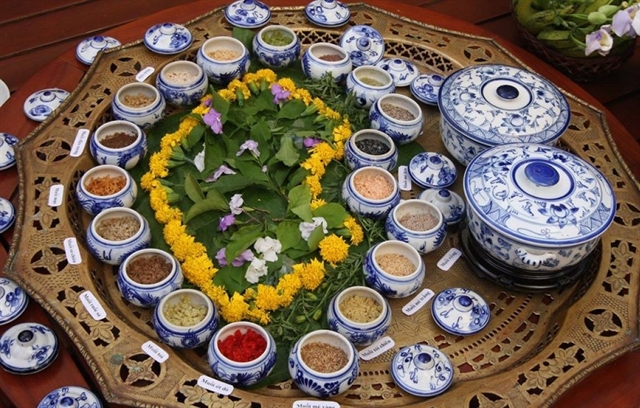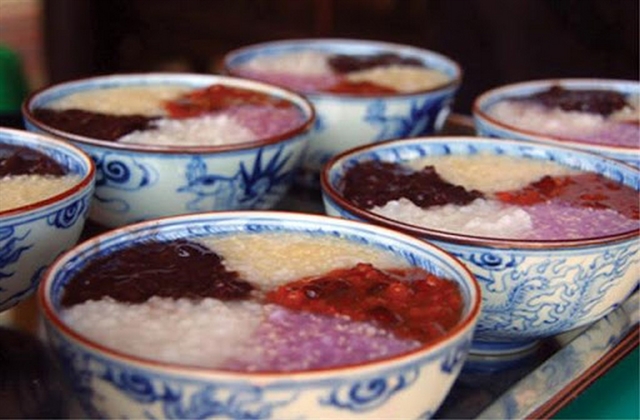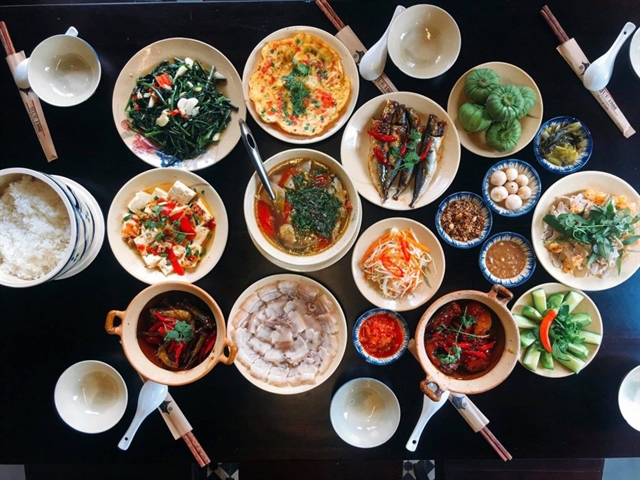Thu Hiền
Huế is not only famous for its ancient royal palaces and mausoleums and romantic scenery with rivers and mountains, the city is also known as the “royal capital of cuisine” that has lured visitors for centuries.
Dishes in Huế are processed from simple ingredients, especially rice with salt, a food that was popular among ordinary people, but also contains significant royal features.
People often said that it’s a great honour to have a chance to taste rice with salt processed in the ancient way of royal tradition in the former citadel Huế.
Eating rice with salt, one absorbs a typical cultural feature of the royal citadel: salty and sweet.

Mentioning rice with salt, people will think of a poor meal with vegetables, pickles, salt and fish sauce.
But from those very poor ingredients, Huế people, by their special capacities, can create delicate dishes surpassing the individual values of the ingredients.
They bring soul to simple ingredients and make ordinary dishes into valuable treasures.
In the past, salt was a rare treasure in the royal citadel, when locals steamed up salt in glazed terracotta jars to turn it into raw grains of salt. The grains of salt had a white colour like that of snowflakes.
The process seems to be easy but processing salt in hot weather to make white grains was an extremely difficult, artisan Tôn Nữ Thị Hà said.
The valuable grains of salt were then used for royal dishes.
In 1825, King Minh Mạng sought to turn the dish into a royal dish with changes to the amount of salt and combining the salt with meat, fish, vegetables and fruits to make mixtures that could be considered to be royal dishes.
Đặng Văn Sơn, a rare chef that can make such a royal dish, said the proper salt used should have a minor salty taste at first, then a little sweet when swallowed in sore throat.
The grains of salt processed in the ancient way can taste much sweeter when being preserved longer.
A royal meal of rice and salt has 20 genres of salt mixtures. But the most popular royal meal has nine kinds of mixtures because Huế people like the number 9, which symbolises sustainability and eternity.
A true art
From white salt, Huế women can create salt of various colours such as bright red salt with chilly, a yellow mixture of salt and galangal, a black mixture of salt and sesame or black pepper, a mixture of salt and cereal or a mixture of salt and oily fruit. All should contain the five flavours of sour, spicy, salty, sweet and bitter. The mixtures are processed in various ways like roasting, stirring in fat, mixing, fermenting in salt and stewing.

Diners should chew the dish slowly to feel all flavours.
Researcher Nguyễn Thị Diệu Thảo said the best local rice, the Nàng Hương genre from Phước Tích Village, should be chosen for the dish. A clay pot should be used to steam the rice and each single grain should be kept intact without being broken during the steaming process. The rice should be properly steamed, not overcooked.
The rice and salt mixtures should be presented in delicate ceramic containers to enhance the appearance and flavours of the dish.
Sơn said to process a mixture of salt requires much time and energy.
“For example, in the mixture of salt and mackerel, the fish should be steamed and crushed well before being mixed with salt over a low temperature for two hours,” he said.
Applying scientific principles
Rice with salt should be twisted according to seasons to reach a yin-yang balance and cool-heat features.

Depending on the season, crop and weather in the year, the amount of salt and the way to process it can vary.
When it rains a lot, with high humidity, and stays cool, Huế people will process more salt with hot, salty and sweet flavours.
In hot summer, they will process more mixtures with bitter and sour tastes.
Huế’s way
There are three groups of salt mixtures: salted meat (pork, beef, chicken, goat, etc.), salted fish (using various kinds of fresh water and sea fish) and salted cereals and fruits (sesame, peanut, pepper, chilly, etc.).
According to food experts, the royal feature is expressed the most in salted lemongrass.
Minced pork should be mixed well with shredded chicken, lemongrass, salt, chilly and shrimp paste, all stirred in fat at a high temperature.
“The dish can be preserved for a long time to eat with steamed rice on cool days. Nothing can compare,” Hà said.
Salted chilly that needs hot chili and salt mixed together is also popular.
There are also salted star fruit, stew salt with galangal, stew salt with garlic and stew salt with black pepper.
Ý Thảo and Tịnh Gia Viên restaurants are among the few places offering this dish in Huế City.
At Ý Thảo Restaurant, each kind of salt will be served with a different dish such as white salt eaten with five-colour gruel; salted bean or sesame served with sticky rice while salted meat and fished is eaten with steamed rice.

Artisan Hoàng Thị Như Huy together with the Việt Nam Cuisine Culture Association are compiling a dossier to submit to UNESCO to recognise the dish as a royal heritage.
“Eating rice with salt is eating Huế culture,” said Huy. “Eating to think, not eating to know.” VNS
- Reduce Hair Loss with PURA D’OR Gold Label Shampoo
- Castor Oil Has Made a “Huge” Difference With Hair and Brow Growth
- Excessive hair loss in men: Signs of illness that cannot be subjective
- Dịch Vụ SEO Website ở Los Angeles, CA: đưa trang web doanh nghiệp bạn lên top Google
- Nails Salon Sierra Madre
 VnExpress News The News Gateway of Vietnam
VnExpress News The News Gateway of Vietnam





